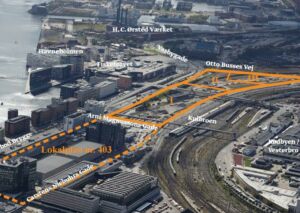News
Historic coal bridge being torn down
This article is more than 10 years old.
Industrial age icon will be but a memory by the end of the year

Kulbroen has been marking the final approach to Central Station for train passengers since 1900 (photo: Københavns Kommune)
Another relic from Denmark’s industrial past is about to disappear into the history books forever.
The old coal bridge Kulbroen, which stretches across the railway tracks between Ingerslevsgade and Kalvebod Brygge and the Central Station in Copenhagen, will be torn down, with the demolition starting on Sunday night.
The culture heritage authorities and Copenhagen Municipality have decided not to protect or keep the bridge, and new development in the area has spelt an end to the icon from Copenhagen’s industrial age.
“The coal bridge has played a big part in the development of Copenhagen,” said Bo Keiser-Nielsen, a spokesperson for HOFOR, the capital region’s heating supplier and owner of the bridge.
“Since 1930, the bridge has shouldered HOFOR’s large district heating pipes that supply Vesterbro with heating.”
READ MORE: Historic buildings in danger of being demolished
Tough task ahead
Erected in 1900, the task of the bridge for many years was to move coal from the harbour to the Vestre Gasværk power plant, which used to be located where Kødbyen is located today.
Passing under the bridge on the train has for millions of passengers marked the final approach to the Central Station for the last 115 years.
But removing the bridge, which is 240 metres long and consists of seven sections each weighing 54 tonnes, won’t be an easy task as most of it stretches over the railway.
The seven sections will be removed one at a time. Part of the work will take place at night to minimise the impact the demolition will have on train traffic and car traffic on Ingerslevsgade and Kalvebod Brygge.
“It’s exciting but not easy to remove such a huge and heavy bridge over the train tracks,” said Erik Gaardsted Madsen, a project manager for MOE, the engineering consultant involved in the project.
“We will be using some of Denmark’s largest cranes, and the work must be co-ordinated with, for instance, Banedanmark, to impact the train traffic as little as possible.”
The bridge, which will be disassembled and its iron parts sold off for recycling, will be completely removed by the end of the year.










































